Dipole and cardioid pattern from open back or double delayed (dsp or distance) driver works only below or at certain freq range (wavelength band). Both loose lots of efficiency/sensitivity as freq goes down (dipole loss). Only benefit for doubling is better sensitivity if drivers are connected electrically parallel. At critical freq (axial dipole null) directivity is practically omni and above it front and backside have different pattern, based on driver diameter, profile and other factors like obstructions from frame, spider, coil/magnet etc.
This limits the usable range of such a radiator to max. three octaves. And because for hifi we need range 30-20 000Hz (9 octaves), at least four different radiator must be used.
The dipole range doesn't have any box edge diffractions or resonances that cause secondary sources making disruptions in on-axis spl or radiation pattern/spl. This way the system has best possible uniform radiation with minimal off-axis radiation that in-room cause eary reflections from sidewalls. The rearside energy will ofcourse get reflected back, but preferably with long delay and attenuated. All this will create the typical sound (good imaging with sensation of depth) that is best suited for classical or other well recorded acoustical or vocal stereo recordings. The practical importance of backside spl and radiation smoothness is questionble though...
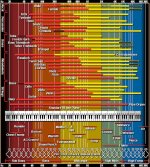
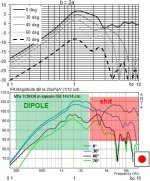
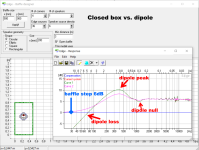
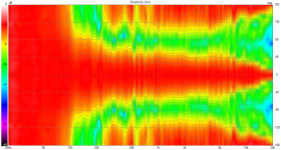
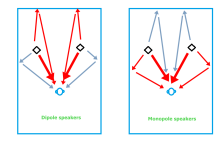
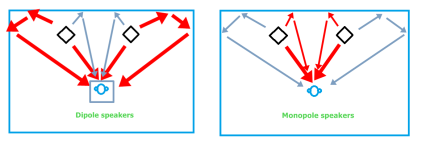
This limits the usable range of such a radiator to max. three octaves. And because for hifi we need range 30-20 000Hz (9 octaves), at least four different radiator must be used.
The dipole range doesn't have any box edge diffractions or resonances that cause secondary sources making disruptions in on-axis spl or radiation pattern/spl. This way the system has best possible uniform radiation with minimal off-axis radiation that in-room cause eary reflections from sidewalls. The rearside energy will ofcourse get reflected back, but preferably with long delay and attenuated. All this will create the typical sound (good imaging with sensation of depth) that is best suited for classical or other well recorded acoustical or vocal stereo recordings. The practical importance of backside spl and radiation smoothness is questionble though...






Well, yes. The region below the first dipole peak is the region where you get a proper dipole radiation pattern. Have a look at the link in post #2 above to Siegfried Linkwitz's site. (Or just see Juhazi's post #21 above.)It seems from your comment that you are counting on this low delay wrap around radiation to cause cancelation to narrow the directivity pattern
It's a fantasy, in a manner of thinking.Dipole and cardioid pattern from open back or double delayed (dsp or distance) driver works only below or at certain freq range (wavelength band). Both loose lots of efficiency/sensitivity as freq goes down (dipole loss). Only benefit for doubling is better sensitivity if drivers are connected electrically parallel. At critical freq (axial dipole null) directivity is practically omni and above it front and backside have different pattern, based on driver diameter, profile and other factors like obstructions from frame, spider, coil/magnet etc.
This limits the usable range of such a radiator to max. three octaves. And because for hifi we need range 30-20 000Hz (9 octaves), at least four different radiator must be used.
The rear wave from a dipole has reversed polarity, so the usual polarity reversal that occurs when sounds reflect off walls flips it back. This confuses the perceived geometry of the room and sound sources.
Instead of hearing "the same boring flat wall" behind the speakers as with many sounds that are mostly monopolar, it no longer makes sense. A "double reflection" might work, like a 90° optical reflector. Even that might not work. Unless somehow twisted around, the phase could stubbornly follow the sound vector, I'm not sure. Even if it can be deciphered, the visual cues would not match the sound, which I guess is part of the fun.
abstract, the wide variation of wavelengths in music makes phase coherency of reflected paths a mess ALWAYS. We always get lots of phase interference sums and nulls anyway (except in an anechoic chamber), but we humans with two ears are rather immune to them. What counts is virtual source location, spl relations and delay.
Nearfield listening (or listening with headphones) neglects reflected cues, then dipole pattern looses it's virtue..
https://www.linkwitzlab.com/rooms.htm
www.davidgriesinger.com
https://www.ansys.com/blog/understanding-psychoacoustics
https://www.aalto.fi/en/department-...ics/communication-acoustics-spatial-sound-and
https://academic.oup.com/edited-volume/28094/chapter-abstract/212177474?redirectedFrom=fulltext
ps. Stereophonic recording and listening is an illusion always. So is multichannel. I recommend for everyone to take a chance to personally listen to good dipole stereo speakers! But still I do understand that everyone wouldn't like the effect, it is so different to "normal" stereo. A plus for dipoles is that spectral balance stays same everywhere in the room, not only at the hot spot.
Nearfield listening (or listening with headphones) neglects reflected cues, then dipole pattern looses it's virtue..
https://www.linkwitzlab.com/rooms.htm
www.davidgriesinger.com
https://www.ansys.com/blog/understanding-psychoacoustics
https://www.aalto.fi/en/department-...ics/communication-acoustics-spatial-sound-and
https://academic.oup.com/edited-volume/28094/chapter-abstract/212177474?redirectedFrom=fulltext
ps. Stereophonic recording and listening is an illusion always. So is multichannel. I recommend for everyone to take a chance to personally listen to good dipole stereo speakers! But still I do understand that everyone wouldn't like the effect, it is so different to "normal" stereo. A plus for dipoles is that spectral balance stays same everywhere in the room, not only at the hot spot.
Last edited:
I would add "with a recording made with two microphones of the space in which a musical performance is taking place"."Juhazi said:I recommend for everyone to take a chance to personally listen to good dipole stereo speakers!
Then, the magic happens... the equipment disappears. This is the reason for dipole speakers.
Ed
Last edited:
That might provide the very best spatial performance, but ime, as long as it's a decent recording with some degree of ambience, my dipoles are very convincing.I would add "with a recording made with two microphones of the space in which a musical performance is taking place".
A well designed dipole pattern speaker certainly makes for an engaging listening experience that brings the performance in to the room.I would add "with a recording made with two microphones of the space in which a musical performance is taking place".
Then, the magic happens... the equipment disappears. This is the reason for dipole speakers.
Ed
About 18 months ago I built a pair of speakers with a remote that could switch them between four radiation patterns (omni, dipole, point source, cardioid). I did my best to EQ each setting using the miniDSP. I took them to our local club meeting, set up the speakers in a fairly reflective room out away from the back wall several feet and then played music recorded as you describe. I handed the remote to different people to switch between the modes. The majority of people switched it around while listening and landed back on the omni-directional pattern. I sold these speakers to a friend and after hearing the different patterns, he just hard wired them as omni-directional.
It could be that the dipole pattern mode of that speaker wasn't up to snuff. As it happens it is relatively easy to find some plans, take a board, cut holes in it and make a good dipole speaker. Building a good omni-directional speaker is a bit more complex and far less common. Short of buy a Bang & Olufsen speaker, there are few or no variable directivity speakers out there for people to make this comparison just sitting there clicking buttons on a remote.
I managed to get a picture of the setup after Dave's boxes were swapped into position. So the variable directivity red spheres on mic stands and black woofer boxes are in the back ground. I don't know how much influence the mural had on the experience.
Last edited:
This doesn't seem unusual.The majority of people switched it around while listening and landed back on the omni-directional pattern.
Earlier this year, I ended up building a pair of 2-way omni speaker with 6.5" Seas woofer and one of SBA's center-pocked 28mm tweeters. They are run active with miniDSP 2x4HD & DSP PEQ, crossover at ~2kHz. They have the unique feature of a pentagon profile tower for the woofer, to reduce internal standing waves. There's also a conical diffuser on the bottom inside panel, again to reduce standing waves. The reflectors are 3D printed. Bass is limited to ~40Hz and modest/mid level (maybe 95 dB@1m in room?). The FR, fairly close to Harmon curve, is essentially identical in a 25-30 degree vertical window all around the speaker.
Everybody who hears these loves them. Positioned 4-5' from the wall in my 400sf studio, they are neutral, open, and natural. They do not sound too diffuse, localization is good, and do very well with any recordings with even a touch of ambience.
I intend to try a 3-way version with 10" or bigger subs soon.
Why aren't omnidirectional speakers more popular, then? Is it because they require placement well out into the room (like dipoles)?
Maybe. Mine sound quite ok just a couple feet off the wall. The dipoles seem to want more room.Why aren't omnidirectional speakers more popular, then? Is it because they require placement well out into the room (like dipoles)?
Popular omnidirectional speakers? For your consideration, with some ~60 million units sold, an apparently mid ? fidelity, omnidirectional powered speaker with digital crossovers that is quietly outselling most everything talked about on this site. At this price point you probably won't get the lowest distortion drivers available. I have yet to hear these, but reviews show an even directivity. It would seem a broken unit acquired from eBay could be hacked to produce different radiation patterns including dipole in the upper frequencies. Out of the box these live in the Apple music ecosphere that I don't regularly use. The speakers we typically see displayed at the major audio shows sell maybe 100 units up to 200,000 units per year.
( https://forums.stevehoffman.tv/threads/speaker-sales-numbers.1091428/ )
The circular array of folded ( bent? ) horns is certainly interesting.


Ohm Speakers is still selling their more conventional passive speaker. It is omnidirectional in the
bass and midrange, with a forward firing tweeter. https://ohmspeaker.com/

( https://forums.stevehoffman.tv/threads/speaker-sales-numbers.1091428/ )
The circular array of folded ( bent? ) horns is certainly interesting.
Ohm Speakers is still selling their more conventional passive speaker. It is omnidirectional in the
bass and midrange, with a forward firing tweeter. https://ohmspeaker.com/
Last edited:
Ok, let me revise the question--why aren't omnidirectional speakers more popular among audiophiles?
And to be clear, I'm genuinely interested. In fact, I don't think I've ever heard a pair of them set up in stereo. Not even at some big shows.
But I've liked most of the OB systems I've heard thus far and am now curious what omni offers when (ironically?) set up in stereo.
And to be clear, I'm genuinely interested. In fact, I don't think I've ever heard a pair of them set up in stereo. Not even at some big shows.
But I've liked most of the OB systems I've heard thus far and am now curious what omni offers when (ironically?) set up in stereo.
Just make a pair. Upright tube 2-way + reflectors. Use minidsp 2x4hd. If you're interested, PM me for the 3D reflector files -- easily modified for larger/different drivers. Or even start with a single full range driver.But I've liked most of the OB systems I've heard thus far and am now curious what omni offers when (ironically?) set up in stereo.
All the reflections from the omni are bouncing the same energy mix, so there's great consistency in the ambient gestalt (for want of a better word). They blend well acoustically into the room. I'm sure someone can explain this better.
And BTW, when I was digging into omnis, I found those that like them really like them.
The bigger design I'm thinking of is a 27-28" tall tower with Peerless SLS10 force-cancelling woofers on opposing sides at the bottom, a small sealed or aperiodic chamber on top for a 5~7" mid & tweeter. Reuse the reflectors & from my current omnis. Xovers at 200Hz & 2kHz.
Omnis create more boundary reflections than dipoles. Thus stereo image wouldn't be so sharp and stabile. My guess is that they are more critical to placement (or room type) than dipoles, but I might be wrong, at least small moves shouldn't matter much.
A single monophonic omni is ok, but stereo....
A single monophonic omni is ok, but stereo....
Not in my studio. Tried against the usual wall, about 2' out to 5', and 5' to 8' apart. More tolerant to close wall than big dipoles; otherwise, similar. Stereo image is usually solid, quite detached from speakers.Thus stereo image wouldn't be so sharp and stabile. My guess is that they are more critical to placement (or room type) than dipoles,
Only tried in one other huge room where imaging (and overall sound) wasn't as good especially farther than 8' from speakers. Not unexpected, given modest woofer.
I have omni pair at my summer cabin, vintage Sonabs. They are next to wall, other sometimes in the corner. Imaging is poor but spl response is nice. It was very difficult to hear if polarity was similar! I have a pair of small 2-ways on the terrace, but I have never tested them indoors for comparison. Friends have similar pair in as bad locations and imaging is zero. But I don't want to make a statement based on this.


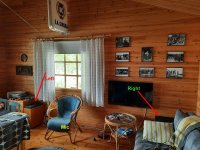
Comparison of 4-way dipole vs. 2-way omni both in-room near to wall
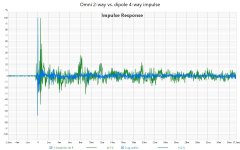
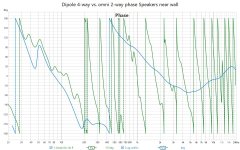


Comparison of 4-way dipole vs. 2-way omni both in-room near to wall


Last edited:
Those Sonabs look too low... but I'm guessing there are multiple tweeters facing different directions? Not great positioning tho. FR is pretty amazing, actually! Where were the mic/spkers?
SL's view was that omnis require near-field listening or a dead room, otherwise the ratio of indirect/direct sound will be too great. (He was very much concerned with stereo image, though.)
- Home
- Loudspeakers
- Multi-Way
- Understanding dipole "equivalent" layouts + possible pros/cons